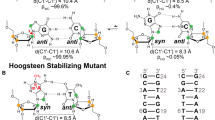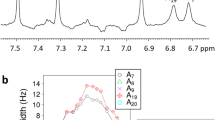Abstract
Sequence-specific 1H NMR assignments are presented for a non-selfcomplementary 23-base-pair DNA duplex of molecular weight 15,000 daltons, containing the OR3 repressor binding site of bacteriophage λ as the central core. The NMR techniques used were mainly phase-sensitive two-dimensional NOE and 2Q spectroscopy, the latter to overcome overlap problems within the spectral region of the deoxyribose spin-systems. Direct sequential NOE connectivities are observed between adenine 2H and deoxyribose 1′ protons. We propose the use of these connectivities as a check of the assignments of C1′ and A2 protons, which have independently been derived via other assignment pathways.
Similar content being viewed by others
Abbreviations
- COSY:
-
2-dimensional correlated spectroscopy
- NOESY:
-
2-dimensional nuclear-Overhauser-enhancement spectroscopy
- RELAYED-COSY:
-
2-dimensional relayed coherence transfer spectroscopy
- 2Q:
-
two-quantum
- ppm:
-
parts per million
- 23-bp DNA:
-
d-(ATCTATCACCGCAAGGGATAAAT) · d-(ATTTATCCCTTGCGGTGATAGAT)
- 17-bp DNA (OR3):
-
d-(TATCACCGCAAGGGATA) · d-(TATCCCTTGCGGTGATA)
- di(X;Y):
-
intra-residue distance between protons X and Y
- ds(X;Y):
-
sequential distance between protons X and Y located in sequentially neighbouring nucleotides, where the direction from X to Y is always from 5′ to 3′
References
Alexeev DG, Lipanov AA, Skuratovski IY (1987) The structure of poly(dA) · poly(dT) as revealed by an X-ray fibre diffraction. J Biomol Struct Dyn 4:989–1012
Aue WP, Bartholdi E, Ernst RR (1976) Two-dimensional spectroscopy. Application to nuclear magnetic resonance. J Chem Phys 64:2229–2246
Benevides JM, Lemeur D, Thomas Jr GJ (1984) Molecular conformations and 8-CH exchange rate of purine ribo- and deoxyribonucleotides: Investigation by Raman spectroscopy. Biopolymers 23:1011–1024
Boelens R, Scheek RM, Dijkstra K, Kaptein R (1985) Sequential assignment of imino- and amino-proton resonances in 1H NMR spectra of oligonucleotides by two-dimensional NMR spectroscopy. Application to a lac operator fragment. J Magn Reson 62:378–386
Brandes R, Ehrenberg A (1986) Kinetics of the proton-deuteron exchange at position H8 of adenine and guanine in DNA. Nucleic Acids Res 14:9491–9508
Braunschweiler L, Bodenhausen G, Ernst RR (1983) Analysis of networks of coupled spins by multiple quantum NMR. Mol Phys 48:535–560
Celda B, Widmer H, Leupin W, Chazin WJ, Denny WA, Wüthrich K (1988) Studies of the conformation of d-(AAAAATTTTT)2 using constraints from nuclear Overhauser effects and from quantitative analysis of the cross peak fine structures in two-dimensional 1H nuclear magnetic resonance spectra. Biochemistry (in press)
Chazin WJ, Wüthrich K, Rance M, Hyberts S, Denny WA, Leupin W (1986) 1H nuclear magnetic resonance assignments for d-(GCATTAATGC)2 using experimental refinements of established procedures. J Mol Biol 190:439–453
Conner BN, Yoon C, Dickerson JL, Dickerson RE (1984) Helix geometry and hydration in an A-DNA tetramer: IC-C-G-G. J Mol Biol 174:663–695
Dickerson RE (1983) Base sequence and helix structure variation in B and A DNA. J Mol Biol 166:419–441
Dickerson RE, Drew HR (1981) Structure of a B-DNA dodecamer: II. Influence of base sequence on helix structure. J Mol Biol 149:761–786
Drew HR, Loing RM, Takano T, Broka C, Tanaka S, Itakura K, Dickerson RE (1981) Structure of a B-DNA dodecamer: Conformation and dynamics. Proc Natl Acad Sci USA 78:2179–2183
Drew HR, Samson S, Dickerson RE (1982) Structure of a B-DNA dodecamer a 16 K. Proc Natl Acad Sci USA 79: 4040–4044
Eich G, Bodenhausen G, Ernst RR (1982) Exploring nuclear spin systems by relayed magnetization transfer. J Am Chem Soc 104:3731–3732
Fratini AV, Kopka ML, Drew HR, Dickerson RE (1982) Reversible bending and heliz geometry in a B-DNA dodecamer: CGCGAATTBrCGCG. J Biol Chem 257:1486–14707
Hahn KD, Rüterjans H, Chernov BK, Skryabin KG, Kirpichnikov MP (1985) 1H NMR study of the interaction of bacteriophage λ cro protein with the OR3 operator. II. Assignment of the non-exchangeable proton resonances of the OR3 operator. Eur Biophys J 12:87–95
Hanstock CC, Lown JW (1984) Two-dimensional doublequantum spectroscopy for the hydrogen NMR assignment of deoxyribonucleotides. J Magn Reson 58:167–172
Hare D, Wemmer DE, Chou SH, Drobny G, Reid BR (1983) Assignment of the non-exchangeable proton resonances of d-(C-G-C-G-A-A-T-T-C-G-C-G) using two-dimensional nuclear magnetic resonance methods. J Mol Biol. 171:319–336
Jeener J, Meier BH, Bachmann P, Ernst RR (1979) Investigation of exchange processes by two-dimensional NMR spectroscopy. J Chem Phys 71:4546–4553
Kalk A, Berendsen HJ (1976) Proton magnetic relaxation and spin diffusion in proteins. J Magn Reson 24:343–366
Kintanar A, Klevit RE, Reid BR (1987) Two-dimensional NMR investigation of a bent DNA fragment: Assignment of the proton resonances and preliminary structure analysis. Nucleic Acids Res 15:5845–5862
Kirpichnikov MP, Hahn KD, Buck F, Rüterjans H, Chernov BK, Kurochkin A, Skryabin KG, Bayev AA (1984) 1H NMR study of the interaction of bacteriophage λ Cro protein with the OR3 operator. Evidence for a change of the conformation of the OR3 operator on binding. Nucleic Acids Res 12: 3551–3561
Kumar A, Ernst RR, Wüthrich K (1980) A two-dimensional nuclear Overhauser enhancement (2D NOE) experiment for the elucidation of complete proton-proton cross-relaxation networks in biological macromolecules. Biochem Biophys Res Commun 95:1–6
Minganti C, Ganesh KN, Sproat BS, Gait MJ (1985) Comparison of confrolled pore glass and Kieselguhr-polydimethylacrylamide composite as supports for solid-phase synthesis of 23-residue oligodeoxynucleotides in milligram amounts. Anal Biochem 147:63–74
Nilges M, Clore GM, Gronenborn AM, Piel N, McLaughlin LW (1987) Refinement of the solution structure of the DNA decamer 5′d (CTGGATCCAG)2: Combined use of nuclear magnetic resonance and restrained molecular dynamics. Biochemistry 26:3734–3744
Otting G, Grütter R, Leupin W, Minganti C, Ganesh KN, Sproat BS, Gait MJ, Wüthrick K (1987) Sequential NMR assignments of labile protons in DNA using twodimensional nuclear-Overhauser-enhancement spectroscopy with three jump-and-return pulse sequences. Eur J Biochem 166:215–220
Patel DJ, Kozlowski SA, Marky LA, Broka C, Rice JA, Itakura K, Breslauer KJ (1982) Premelting and melting transitions in the d-(CGCGAATTCGCG) self-complementary duplex in solution. Biochemistry 21:428–436
Rance M, Wright PE (1986) Analysis of 1H NMR spectra of proteins using multiple quantum coherence. J Magn Reson 66:372–378
Scheek RM, Russo N, Boelens R, Kaptein R, van Boom JH (1983) Sequential resonance assignments in DNA 1H NMR spectra by two-dimensional NOE spectroscopy. J Am Chem Soc 105:2914–2916
Scheek RM, Boelens R, Russo N, van Boom JH, Kaptein R (1984) Sequential resonance assignments in 1H NMR spectra of oligonucleotides by two-dimensional NMR spectroscopy. Biochemistry 23:1371–1376
Shakked Z, Rabinovich D, Kennard O, Cruse WB, Salisbury SA, Viswamitra MA (1983) Sequence-dependent conformation of an A-DNA double helix. The crystal structure of the octamer d(G-G-T-A-T-A-C-C). J Mol Biol 166:183–201
Suzuki E, Pattabiraman N, Zon G, James TL (1986) Solution structure of [d(A-T)5]2 via complete relaxation matrix analysis of two-dimensional nuclear Overhauser effect spectra and molecular mechanics calculations: Evidence for a hydration tunnel. Biochemistry 25:6854–6865
Ulrich EL, John EM, Gough GR, Brunden MJ, gilham PT, Westler WM, Markley JL (1983) Imino proton assignment in the proton nuclear magnetic resonance spectrum of the λ phage OR3 deoxyribonucleic acid fragment. Biochemistry 22:4362–4365
Wagner G, Wüthrich K (1979) Truncated driven nuclear Overhause effect (TOE). A new technique for studies of selective 1H-1H Overhauser effects in the presence of spin diffusion. J Magn Reson 33:675–680
Weiss MA, Pater DJ, Sauer RT, Karplus M (1984) 1H-NMR study of the λ operator site OL1: Assignment of the imino and adenine H2 resonances. Nucleic Acids Res 12: 4035–4047
Wemmer DE, Chou SH, Reid BR (1984) Sequence-specific recognition of DNA: Nuclear magnetic resonance assignments and structural comparison of wild-type and mutant λ OR3 operator DNA. J Mol Biol 180:41–60
Wing RM, Pjura P, Drew HR, Dickerson RE (1984) The primary mode of binding of cisplatin to a B-DNA dodecamer: C-C-C-G-A-A-T-T-C-G-C-G. EMBO J 3:1201–1206
Wüthrich K (1986) NMR of proteins and nucleic acids. Wiley, New York, pp 203–255
Author information
Authors and Affiliations
Rights and permissions
About this article
Cite this article
Grütter, R., Otting, G., Wüthrich, K. et al. OR3 operator of bacteriophage λ in a 23 base-pair DNA fragment: Sequence-specific 1H NMR assignments for the non-labile protons and comparison with the isolated 17 base-pair operator. Eur Biophys J 16, 279–286 (1988). https://doi.org/10.1007/BF00254064
Received:
Accepted:
Issue Date:
DOI: https://doi.org/10.1007/BF00254064




